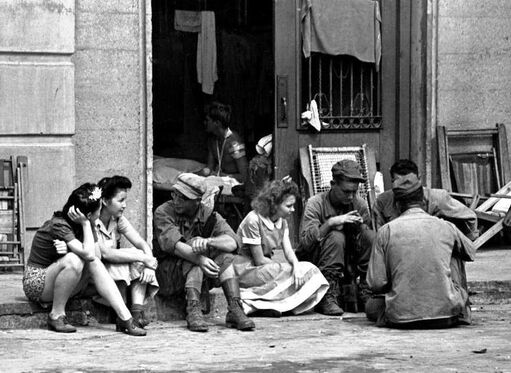 Hope plans. Though she clung to the dream that American troops would soon liberate them, Hope did not put her trust in imminent release from danger. By late 1944, STIC prisoners were dying each day of starvation: she herself (5’3”) weighed less than 90 pounds. On September 22, 1944, the day after the first American planes overflew the camp and bombed Manila harbor (signaling to internees that help was on the way), Hope was on her knees outside her shanty, planting a little garden. When confronted by incredulous friends, who demanded to know what she was doing when liberation was only “days away,” she reminded them of the story of the Little Red Hen, and begrudgingly some decided to help her. Indeed, for the next four months that garden bore fruit (actually, spinach-like talinum, garlic, and mint) to tide them over. Hope draws on memory. Hope Miller’s memories were partly those of her Granite State girlhood at the foot of Mount Sunapee and of her husband, George. But hers was also the shared American memory: a sense of her nation’s story and her connection to it, a deep conviction that she was part of her country’s historic quest for freedom, liberty, and the wide open spaces that epitomized those qualities. For a Thanksgiving Day performance, after ten months of captivity, Hope had her fifth graders memorize and perform Stephen St. Vincent Benet’s, “The Ballad of William Sycamore.” In that poem, a Great Plains pioneer laments losing his two sons in battle -- one, at the Alamo and another at Little Big Horn, but “still could say, ‘So be it.’ But I could not live when they fenced the land, for it broke my heart to see it.’” On folding chairs, behind the iron bars of Santo Tomas, there was not a dry eye in the house. On Washington’s Birthday in 1944, Hope participated in a reading of Maxwell Anderson’s play, Valley Forge. Freedom, the play reminded these Americans in captivity, was often forged in time of trial. Endurance was part of the national drama. In mid-February, days after they were liberated, a young soldier sat next to Hope in the halls of Santo Tomas, staring at the emaciated men and women newly rescued and quietly taking in the cracked walls and squalid living conditions. While other GIs joked and chatted with internees, this “Still-Waters-Run-Deep” fellow put his hand on Hope’s forearm and said quietly, “Tell me. Did you ever despair?” In her written memoir, Hope writes, “My answer seemed very important to him.” And truth be told, if anyone had reason to despair it might have been Hope, who would return to the United States at age forty-one, widowed, childless, and penniless … to start all over. But instead, she couldn’t suppress a smile, took a drag from her cigarette and exhaled with satisfaction. “No. You see,” she turned toward the young man as if it were very important that he understand each gravelly word, “We knew you’d come back. We just knew it.” She held his eyes for a long moment and relished the childlike smile that suffused his face. Faith, hope, and love. Maybe in May of 2020, our time of national confinement, the greatest of these is hope. Hope is not a cheerful Candide, but a gritty Can-Do. True hope teaches us to endure, leads us to work, prompts us to lose ourselves in the needs of others, and draws strength from memory: our own treasured stories and those of others in our land who persevered in times of adversity. Mary Beth Klee is the author of Leonore’s Suite, a recently published novel about the experience of American civilians interned by the Japanese in Santo Tomas. Hope Miller's story is told therein and draws on Hope Miller Leone’s unpublished manuscript, Nor All Your Tears. To read more from Telling Our Stories, visit our Blog Archives page. |
AuthorWrite something about yourself. No need to be fancy, just an overview. Archives
July 2024
Categories |
